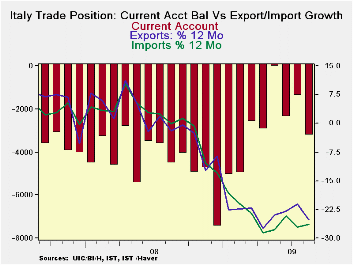 Global| Oct 16 2009
Global| Oct 16 2009Italy's Trade Gap Widens On Weaker Exports
Summary
Italy’s exports and imports both dropped on the month with exports dropping faster. As a result, the trade gap widened. But the gap has improved from its worst level at end of 2008. True, the deficit has expanded again from it best [...]

Italy’s exports and imports both dropped on the month with
exports dropping faster. As a result, the trade gap widened. But the
gap has improved from its worst level at end of 2008. True, the deficit
has expanded again from it best level in May of 2009, but both exports
and imports are on the mend. The export drop this month was
particularly large and therefore it is hard to put in context; it will
take several more months to figure out if this is a new trend of sorts,
or an oddity.
One problem is that Germany, too, had reported a sharp and
unexpected drop in exports. So the Italian drop may have something to
it. Even so it could be that the same rogue factor affected both of
them, it could be a coincidence, or it could be a fundamental weakening
in exports. It will take time to tell
Because of the relatively sharp drop this month, -15.9% for
exports Vs -8.8% for imports, the Yr/Yr trends are probably distorted.
But both export and import growth are down sharply across major
category components (see the table, at the bottom).
While all nations are banking on trade to become an engine of
growth, US demand seems to be slow in starting and most industrialized
economies are having a hard time getting into gear, too. It is in this
environment in which it is hard to see why up to this point exports
have responded so well in the cycle. One man’s export is another’s
import and ultimately is linked to domestic demand which remains
globally challenged: that is the part that is hard to figure out. Whose
export demands have been strong and will they stay that way?
| Italy's Trade Trends | |||||||
|---|---|---|---|---|---|---|---|
| m/mo % monthly rate | Period Specified saar | ||||||
| Seasonally Adjusted | Aug-09 | Jul-09 | Jun-09 | 3-MO | 6-Mo | 12-Mo | Yr-Ago |
| Current Account Bal | €€(3,237) | €€(1,382) | €€(2,378) | €€(2,332) | €€(2,099) | €€(3,656) | €€(3,927) |
| Goods Balance | €€(1,086) | €€814 | €€939 | €€222 | €€592 | €€163 | €€86 |
| Exports | -15.9% | 11.8% | -1.3% | -25.7% | -22.4% | -24.4% | -8.9% |
| Imports | -8.8% | 12.9% | 1.2% | 17.9% | -10.9% | -26.0% | -2.4% |
| Services Balance | €€ 352 | €€ (399) | €€ (788) | €€ (278) | €€ (585) | €€ (766) | €€ (458) |
| Exports | 10.4% | 5.8% | -0.4% | 83.3% | 41.6% | -0.7% | -2.9% |
| Imports | -1.7% | -0.8% | 3.3% | 3.0% | -15.6% | -12.1% | -3.3% |
| Not Seasonally Adjusted | All Yr/Yr | ||||||
| Exports | Aug-09 | Aug-08 | Aug-07 | Aug-06 | |||
| Food&Bev | -1.7% | -1.7% | 7.2% | 10.1% | |||
| Capital Gds | -24.9% | -8.2% | 15.9% | 12.5% | |||
| Transport | -23.9% | -7.9% | 9.0% | 14.9% | |||
| Consumer Gds | -14.1% | -11.5% | 8.0% | 8.3% | |||
| Other Gds | -44.2% | 4.3% | 4.5% | 20.0% | |||
| Imports | Aug-09 | Aug-08 | Aug-07 | Aug-06 | |||
| Food&Bev | -10.5% | -0.5% | 6.4% | 6.9% | |||
| Capital Gds | -22.4% | -10.5% | 13.1% | 6.0% | |||
| Transport | -21.9% | -6.2% | 11.6% | 5.6% | |||
| Consumer Gds | -8.5% | -5.7% | 8.3% | 9.1% | |||
| Other Gds | -42.6% | 9.7% | -0.1% | 33.4% | |||
| Balances in Mlns of euros | |||||||
Robert Brusca
AuthorMore in Author Profile »Robert A. Brusca is Chief Economist of Fact and Opinion Economics, a consulting firm he founded in Manhattan. He has been an economist on Wall Street for over 25 years. He has visited central banking and large institutional clients in over 30 countries in his career as an economist. Mr. Brusca was a Divisional Research Chief at the Federal Reserve Bank of NY (Chief of the International Financial markets Division), a Fed Watcher at Irving Trust and Chief Economist at Nikko Securities International. He is widely quoted and appears in various media. Mr. Brusca holds an MA and Ph.D. in economics from Michigan State University and a BA in Economics from the University of Michigan. His research pursues his strong interests in non aligned policy economics as well as international economics. FAO Economics’ research targets investors to assist them in making better investment decisions in stocks, bonds and in a variety of international assets. The company does not manage money and has no conflicts in giving economic advice.






